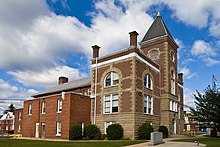Mineral, West Virginia
| Mineral County, West Virginia | |
|---|---|

Mineral County Courthouse in Keyser
|
|
 Location in the U.S. state of West Virginia |
|
 West Virginia's location in the U.S. |
|
| Founded | February 1, 1866 |
| Seat | Keyser |
| Largest city | Keyser |
| Area | |
| • Total | 329 sq mi (852 km2) |
| • Land | 328 sq mi (850 km2) |
| • Water | 1.4 sq mi (4 km2), 0.4% |
| Population (est.) | |
| • (2015) | 27,451 |
| • Density | 84/sq mi (32/km²) |
| Congressional district | 1st |
| Time zone | Eastern: UTC-5/-4 |
| Website | www |
Mineral County is a county in the U.S. state of West Virginia. It is part of the Cumberland, MD-WV Metropolitan Statistical Area. As of the 2010 census, the population was 28,212. Its county seat is Keyser. The county was founded in 1866.
Mineral County is part of the Cumberland, MD-WV Metropolitan Statistical Area.
Indigenous peoples lived throughout the highlands along rivers in this area for thousands of years. Archeologists have identified artifacts of the Adena culture, dating from 1000 BC to 200 BC. They were among the several early Native American cultures who built major earthwork mounds for ceremonial and burial use. Remnants of their culture have been found throughout West Virginia. They were followed by other indigenous peoples.
With the growth of fur trading to the north after European encounter in the coastal areas, the nations of the Haudenosaunee (or Iroquois Confederacy), based in present-day New York, moved into the Ohio Valley in search of new hunting grounds. By the 17th century they had conquered other tribes, pushed them out to the west, and preserved the area for hunting.
It was not until after West Virginia became a state in 1863 that present-day Mineral County was organized. It was created in 1866 by an Act of the West Virginia Legislature from the existing Hampshire County. The name was selected due to its reserves of minerals, especially coal (although, technically, coal is not a true mineral).
The seminal point in the creation of the county was the arrival of the main line of the Baltimore and Ohio Railroad in 1842. The county seat of Keyser was named for an executive of the railroad.
...
Wikipedia
